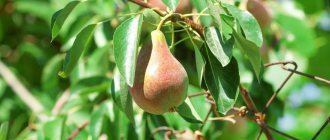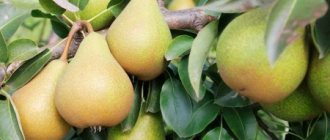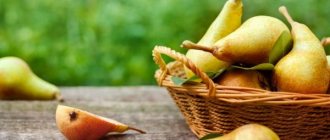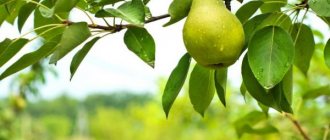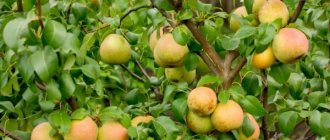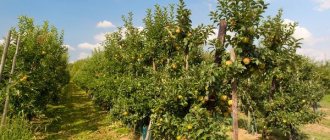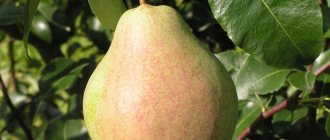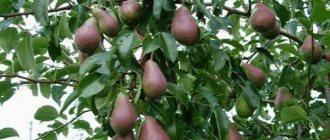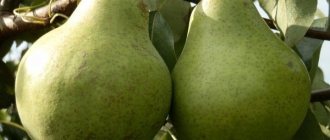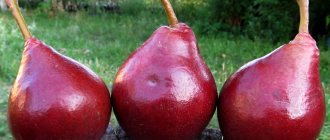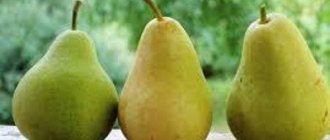Gardening » Pear
0
1177
Article rating
Kira Stoletova
Vekovaya pear is a variety that has been bred for more than 20 years. It is still popular among gardeners today due to its stable yields.
Characteristics of the Vekovaya pear variety
Characteristics
She won the hearts of many gardeners. The Vekovaya pear variety (reviews about it are mostly positive) is a medium-sized tree. Winter hardiness indicators are relative. The first fruits can be tasted four years after planting. They are collected in the autumn.
Despite all the positive aspects that the Vekovaya pear has, reviews from gardeners also include the following disadvantages:
- scab damage;
- tick;
- bacterial burns.
But at the same time, it has the advantage of having a very high annual yield. The Vekovaya pear, the description of the features of which is presented above, has fruits of the correct shape. They differ in that a third of the fruit is covered with a bright blush, and the main color is yellow.
The Vekovaya pear variety also has positive reviews from entrepreneurs. The thing is that its fruits are highly marketable; the weight of one fruit is approximately 150 g.
The Vekovaya pear (description, photo, reviews about it you can see in the article) has fruits that are white, very juicy, and have a sweet and sour taste. Some fruits weigh half a kilogram.
The Vekovaya pear bears fruit (the description of the variety will not be complete without this data) in the autumn. The peak harvest time is mid-autumn.
Characteristics of the Vekovaya pear
The Vekovaya pear variety was developed by crossing the Ussuri and cultivated pears.
- self-sterile;
- begins to bear fruit 3–4 years after planting;
- yields are stable;
- the fruits ripen by the end of September;
- winter hardiness is average;
- resistance to diseases is above average.
- Drought resistance is average.
The tree was bred for the Siberian and Ural regions. In areas with severe frosts and little snow cover, additional winter shelter is required.
The age-old tree needs a pollinator tree. A suitable variety is Severyanka. .
Frost resistance
Since the “Vekovaya” variety was bred on the border of the Urals and Siberia, it is quite resistant to frost. Since temperatures in this area can reach 15 degrees below zero, the plant is adapted to the climatic conditions. High regenerative capacity ensures the survival of the buds during the frosty period. At the present stage of development of fruit and berry farming, research is being carried out aimed at studying the frost resistance of the root system of trees under controlled conditions.
Fruiting
The plant has a good degree of precocity, however, the first appearance of fruits on the tree will occur 4 years after planting the tree and thereafter will bear fruit annually.
Maturation period
Since the Vekovaya variety pear is an autumn ripening tree, you can prepare for the harvesting process in early September. The shelf life of freshly picked fruits reaches a month.
The ripening period lasts about 6–10 days. This depends on the weather conditions prevailing in the area where the tree grows. So, in dry summers, fruits will ripen faster, and in cool weather, on the contrary, slower. After this period, the remaining fruits on the trees fall off and rot if they are not removed in a timely manner.
Productivity
The yield of one pear tree can reach 150 kg. And taking into account the frequency of fruiting, you can achieve an annual yield of 200 c/ha. Sometimes tree branches break under the weight of growing fruits. To avoid this phenomenon, it is necessary to install special structures that will support branches with fruit. This will give the fruits the opportunity to ripen. You can also tie the skeletal branches with wire.
Application of fruits
Since pears contain vitamins A, B, C, E, K, their consumption is very beneficial for the human body. The fruit is saturated with biologically active substances and contains iron, potassium, zinc, phosphorus, magnesium, calcium and sodium. It also contains a predominance of fiber, which can ensure the normal functioning of the human body.
Landing
The most important thing is to plant the tree correctly. If all the rules listed below are observed, the seedling will bear its first fruits after four years. Pear Vekovaya, description, photo, reviews of which we briefly studied, is very picky in this matter. We offer you step-by-step instructions:
- Treat the plant so that it looks like a regular stick without branches or leaves. To do this, cut off the powerful thick roots by about ten centimeters, and cut off the top. The height of our planting material should be about eighty (plus/minus five) centimeters. Place the seedling in a bucket of water for an hour.
- After an hour has passed, dig a hole, mix the soil with ash equally, dilute with water to the consistency of sour cream. We carefully treat the roots of the plant with the resulting composition.
- There is another feature of how the Vekovaya pear is planted. Reviews from gardeners say that in order for the tree to take root, it is necessary to prepare the bottom before the process. To begin, loosen the soil as best as possible and send ten raw eggs there (no need to break them). After this, pour out the mixture of ash and soil, and sprinkle dry soil on top. Only after all the steps do we plant the tree, without compacting the soil too much.
The Vekovaya pear variety (we are already familiar with the photo and description of the variety) is very finicky. After planting the tree, there will be a lot of trouble left. Place another ten chicken eggs around the perimeter, tie the trunk to a peg. Water the tree with plenty of water. In order for the seedling to overwinter well, the area of land around the trunk should be mulched with peat, sawdust or paper; some also use pine needles and compost.
Maturation period
Since the Vekovaya variety pear is an autumn ripening tree, you can prepare for the harvesting process in early September. The shelf life of freshly picked fruits reaches a month.
The ripening period lasts about 6–10 days. This depends on the weather conditions prevailing in the area where the tree grows. So, in dry summers, fruits will ripen faster, and in cool weather, on the contrary, slower. After this period, the remaining fruits on the trees fall off and rot if they are not removed in a timely manner.
Treatment
The Vekovaya pear variety, like other varieties, requires care and attention. Planting a tree is still a very small task; it is susceptible to many pests. This means you need to know how to treat it against parasites.
How will the Vekovaya pear feel? The description of the variety confirms that it clearly does not cope with diseases. And we will give examples of salvation using exclusively biological materials, and reveal the secrets of experienced gardeners.
So, according to their reviews, the most dangerous disease for pears is moniliosis. Surely you noticed that the pear seemed to burn before your eyes in the shortest possible time; this is a moniliosis burn. We struggled with this problem for a very long time, more than five years, but the result was worth it. The best remedy at the moment is phytolavin. Note that the treatment should be carried out in early spring or autumn, in the evening.
Description of the variety
The Vekovaya pear appeared as a result of crossing the Ussuri pear and an elite seedling of a cultivated pear in 1980. A group of Ural breeders has created a variety with good taste of fruits, which is recommended to be grown in the Ural and Siberian regions.
Description of the tree
Century old.
The crop reaches a height of 5-6 meters, the crown is wide, round, compact, growing up to 5 meters in diameter. The shoots are light brown, the leaves are oval, the flowers are white, large.
The pear has a deep root system, so it is planted in areas with low groundwater levels.
Description of fruits
The fruits are large, weighing from 140 to 220 grams, individual specimens can weigh up to 400 grams. The shape of the fruit is typical of a pear. The skin is thin, green-yellow, with a red blush; when ripe, the color of the fruit is yellowish with a bright red blush on the side.
The pulp is white, juicy, sweet and sour. Tasting score 4.8 points out of 5.
Fitolavin
What is it? Fitolavin is an antibiotic of biological origin. Spraying with this preparation must be carried out on a flowering tree, that is, in early spring. It is very important that this drug is not phytotoxic. The effect is that it will inhibit the development of the fungus for about three weeks. Taking into account the fact that it is non-toxic, the treatment is repeated after flowering. This will not cause any harm to the bees pollinating the pear.
You may notice that young branches are more often affected by moniliosis burn. This occurs as a result of pest bites. Infection begins at the site of the bite, spreading rot further down the branch. Considering this fact, you can defeat the infection with the help of pruners, simply by getting rid of the shoots affected by the fungus. If rot has covered most of the tree, then it’s time to take a saw to save the pear.
Recommendations
It was said above that the affected branches need to be pruned, and you will learn how to do this below.
On diseased branches the bark turns black, which will be hard to see at first. You need to practice, and then detecting diseased shoots will not bring much trouble. In addition to the fact that the bark is black, it is also slightly pressed inward. It is necessary to trim approximately three centimeters below the rot. The remains need to be disposed of, namely, burned.
To reduce problems, consider and follow the following rules:
- Treat the plant in early spring, during flowering.
- Spray again after flowering.
- Mandatory prevention against parasites takes place in late autumn, after the leaves have been shed.
Between treatments, it is imperative to additionally spray with tank mixtures. This must be done in order to prolong the effect of phytolavine. It increases three times, or even more.
If you are financially unable to afford such an expensive product, then treat it with any available product containing a biofungicide. It not only helps in pest control but also promotes tree growth.
Spring treatment of plants
Carrying out spring treatment of pear plantations against major pests and diseases is a necessary part of proper care of fruit trees. The Vekovaya variety pear is sufficiently resistant to the most common diseases and pests, which allows the number of chemical treatments used to be reduced to a minimum. However, in early spring it is necessary to carry out a number of measures to reduce the risk of damage to fruit trees to almost zero:
- in March, even before the stage of active bud bursting, the trunk is pruned and cleaned, as well as subsequent treatment of the plantings with Preparation 30, which makes it possible to destroy the bulk of wintering plant parasites;
- in April, fruit plants are sprayed over a green cone with 1% Bordeaux mixture or a solution of the Abiga Peak preparation, which is necessary for comprehensive protection of pears from the most common fungal and bacterial diseases;
- At the budding stage and immediately after flowering, plants are protected by spraying with such modern and effective means as “Strobi”, “Inta Vir”, “Sumi alpha”, “Kemifos” and “Horus”.
Also in the spring, fruit trees are pruned by cutting into rings and shortening branches. Spring pruning of pear trees is aimed not only at the correct formation of a productive crown, but also at the removal of all old, diseased or frostbitten branches under the influence of severe winter cold.
The first pruning is carried out in the second year after planting the pear seedling. Spring pruning of pears is done in early spring, before sap flow and bud formation. In the temperate climatic conditions of central Russia, this period falls on the last ten days of March or the beginning of April. This procedure must be carried out annually.
Other diseases
In addition to the ones described above, other problems may occur:
- Black cancer.
- Fruit rot.
- Scab.
- Cytosporosis.
- Rust.
- Powdery mildew.
- Milky shine.
All these diseases affect the quality of the product, and in addition, they threaten the continued existence of the tree itself. We invite you to get to know each of them. The disease usually manifests itself in early spring. Green, tender leaves become covered with an incomprehensible coating, turn yellow and dry out. These are the first manifestations of the disease. Next, we will consider the most dangerous of them.
Black cancer
Another name for it is Antonov fire. The lesion can be noticeable on the trunk, branches, leaves and fruits. It can be identified by black spots that begin to grow over time. In addition, small red spots appear around the lesion. If you don’t fight this disease, then, according to observations, you won’t be able to eat pears. Spots appear on the fruit, then the fruit dries out and mummifies.
What to do? These ulcers are cut out and burned, and the resulting wounds are treated with special disinfection solutions, for example, copper sulfate. For prevention, it is necessary to spray trees, and be sure to burn the leaves in the fall.
Fruit rot
The Vekovaya pear, a photo of which has already been repeatedly presented in this article, according to gardeners, is also subject to another danger. Now we will talk about fruit rot. It is not difficult even for a beginner to calculate it - all the fruits begin to rot. The peculiarity of the disease is that the fruits do not fall off, but remain on the branches, spreading the infection.
It is worth removing all affected branches and fruits and be sure to burn them. For prevention, spray in the fall and spring, for example, with copper chloride. The disease reaches its peak around mid-summer. But if you notice that the pear is starting to rot, you should act immediately, do not wait until the disease is at its peak, otherwise it will be much more difficult to get rid of it.
Description of the tree
The “Century” pear variety is a medium-sized and winter-hardy tree. It has a rounded crown shape. It is also disease resistant and has a deep root system. In this regard, the tree should not be planted close to groundwater.
The height of the trunk can reach 6 m, and the diameter of the crown can be 5 m. The dense wood of the tree has a fine structure and growth rings. The branches grow egg-shaped leaves, which are arranged in a spiral in several rows. A characteristic feature is that each subsequent leaf deviates from the previous one by 45 degrees.
Did you know? Europeans smoked pear leaves until Columbus brought tobacco to the continent.
The pear tree will begin to bear fruit 4 years after planting. This variety is characterized by positive yield dynamics and bears fruit every subsequent year.
Scab
This is a very dangerous and insidious enemy of the pear. According to gardeners, detecting the disease is not difficult - small spots appear on the leaves, and over time they increase in size.
It is quite difficult to get rid of scab, especially if the trees are planted close to each other - this impairs ventilation. In addition, the disease affects the fruits themselves. They become stained, burst and become rough. Such fruit must be disposed of; it will no longer go to the table.
For prevention, you need to spray the pear and the ground around it with a seven percent urea solution.
Cytosporosis
This disease has another name – stem rot. It is not difficult to guess that the problem can be found on the tree trunk. The peculiarity of the disease, as gardeners say, is that all trees suffer from it, regardless of age. The appearance is promoted by sun and frost burns, drought and some other factors.
At the same time, the color of the trunk changes its usual color to dark red, and gradually the tree begins to dry out. In this case, only a sharp knife will help. Damaged areas must be cut out and the cut areas treated with copper sulfate. Do not delay treatment, otherwise the pear will simply dry out. Prevention consists in the fact that in the spring you need to whiten the tree trunk and promptly get rid of dry branches.
Care
Vekovaya pear responds well to regular feeding. Before the start of the flowering season, nitrogen fertilizers and organic matter are applied to the tree trunk circle. Whitewashing is a must. This protects the bark from sunburn, cracking, infection and pests.
Crown cleaning
In the fall, you need to remove rotten fruits (if any), old branches, and leaves. Water the tree trunk well with water and add phosphorus fertilizers. If there are severe frosts in the region, then add additional mulch (sawdust, rake up the soil) to protect the roots from frost. The trunk itself is tied with burlap or other material.
General recommendations
- trim (shape) the crown annually;
- Once a season, fertilize (spray) with mineral fertilizers;
- During long periods of drought, provide additional watering.
After winter, inspect the crown. If there are frozen branches, remove them and cover the cut area with garden varnish.
For good fruiting, pears need to be fed regularly.
Rust
Pear Vekovaya, reviews, photos and features of which are presented in the article, is also susceptible to this disease. It is detected exclusively on the foliage, and is reflected in the general condition of the tree.
Rust affects the leaves, causing them to turn orange and fall off prematurely. This affects the tree's immunity. To get rid of rust, gardeners advise removing all junipers in the garden - they are the carriers of the infection. Bad fruits and leaves must be disposed of.
For prevention twice a year, in spring and autumn, treat with both biological and chemical preparations. Let us remind you once again that spraying is carried out in the spring before or during flowering, and in the fall after leaf fall.
Powdery mildew
Speaking about the diseases of the Vekovaya pear, we should not forget powdery mildew. Most often, this infection attacks young leaves and shoots. Less commonly, powdery mildew appears on the flowers and fruits themselves.
The leaves become covered with plaque and stop developing. Many of them fall off. If the inflorescences are affected, then those that remain on the tree do not bear fruit, and eighty percent of them simply fall off. If powdery mildew affects a young shoot, it becomes deformed and dries out.
Since this is a fungal disease, drought promotes its spread. To combat the pest, water the tree more often and get rid of dry branches in spring and autumn. Spraying with chemicals will be a good help.
Diseases and pests
The Vekovaya variety has good resistance to scab and fire blight. It also has good resistance to the pear gall mite.
Dangerous Pear Pests
Pears often suffer from pests, they affect the leaves, bark and fruits.
In this article, we have selected 11 of the most harmful insects that harm pear trees, and also ways to destroy them.
Diseases of pear trees
To get what they cherish, gardeners have to work hard, and the reason for this is pear diseases.
Read about 19 common pear diseases and how to combat them.
milky shine
The disease can occur in both young and old plants. The reasons, according to experts, may be:
- improper care;
- dry soil;
- temperature changes;
- exposure to direct sunlight.
When the disease occurs, the foliage does not change its shape, but becomes covered with a cloudy film. The leaves have a slightly metallic tint, become more fragile and fall off earlier. To avoid this disease, you need, first of all, proper and timely tree care and timely agrotechnical measures. If you do everything correctly, the disease will soon go away.
The Vekovaya pear is, according to gardeners, a capricious plant that requires a lot of attention. Having experience, growing such a variety is a mere trifle. A novice gardener should study a lot of materials on processing and caring for this tree.
Don’t make your dacha a hard labor, it should be a place of rest, both spiritual and physical. And useful tips on growing were given in this article - we studied all the dangerous diseases and learned how to get rid of them. Now it will not be difficult for anyone to grow the named pear. In this matter, the main thing is love and patience, since a lot of time will be spent, but the result is worth it. The fruits of this tree are very pleasant to the taste and have a high-quality presentation.
As for reviews from gardeners, the pear called “Century” is an excellent dessert that is best consumed raw. It tastes like the southern varieties of this plant.
Use of fruits
Since pears contain vitamins A, B, C, E, K, their consumption is very beneficial for the human body. The fruit is saturated with biologically active substances and contains iron, potassium, zinc, phosphorus, magnesium, calcium and sodium. It also contains a predominance of fiber, which can ensure the normal functioning of the human body.
Did you know? One pear contains 20% of the daily value of fiber, 6% of potassium and 10% of vitamin C.
Thus, the fruits can be consumed not only raw, but also cooked into compote and preserves from pears, made into jam and candied fruits, and subsequently consumed as food. In folk medicine, this fruit is used as a remedy for constipation and prostatitis.
